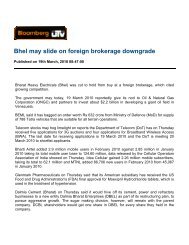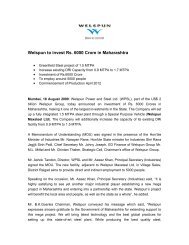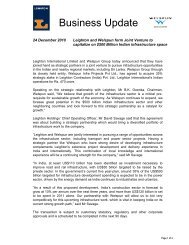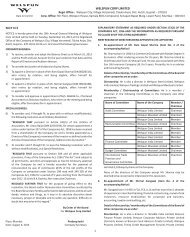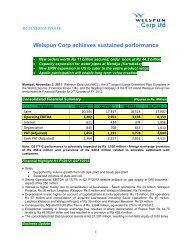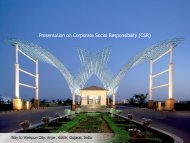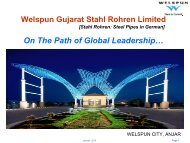Create successful ePaper yourself
Turn your PDF publications into a flip-book with our unique Google optimized e-Paper software.
C rp LtdIndian Steel Pipe Demand overviewLow pipeline penetration in India provides huge potentialCurrently India is developing pipeline infrastructure, with total gas pipeline length of less than 15,000 km, which compares grimly with56,400 km in Pakistan and 18.3 lac km in USA. India has also one of the lowest pipelines spread per sq km of land at 0.003 km/sq km,compared with 1.08 km/sq for UK and 0.19 km/sq for US. This is mainly on account of lower share of natural gas in the primary energymix of the country; it contributes only 9% to the primary energy basket of the country, compared with 21% for world and 24% for OECDcountries.Natural Gas as a source of energy is growing at a rapid pace and shall grow the demand for pipelinesAt the time of independence, natural gas in India started with a negligible part in the total energy basket. Presently it has grown toabout 160 million standard cubic meters per day (MMSCMD). The major domestic producers of natural gas are Reliance IndustriesLimited, Oil & Natural Gas Corporation Limited (ONGC), Oil India Limited (OIL) and JVs of Tapti, Panna-Mukta and Ravv. Governmenthave also offered blocks under New Exploration Licensing Policy (NELP) to private and public sector companies with the right to marketgas at market determined prices. New explorations along with favorable policies of the government would increase a demand for gastransportation infrastructure.Pipeline transport is the most cost effective mode of transportation of petroleum products compared to road and railways. Despitethis, only limited quantities of the total petroleum products are transported through pipelines in India. This has been on account of lowlevel of investments in the past in laying of pipelines in India. However, this is expected to change in the coming years with large capexlined up by hydrocarbon companies and pipelines emerging as the preferred mode of transportation due to its inherent advantagessuch as lower operational cost, safety and protection against pilferage.Major Gas pipeline players have firmed plansMajor oil & gas pipeline players, GAIL, GSPL and RGTIL (Reliance Gas Transportation Infrastructure Ltd.) plan to lay around 13,066 km ofpipelines over the next 3-4 years. At a rate of 200 tonnes/km and conversion rate of US$ 1200/tonne, these three players are expectedto create a total business potential of US$ 3.2 bn. GAIL currently has total gas pipeline length of 7,220 km across India and by <strong>FY</strong>13, it isplanning to take it to 13,825 km with total capital expenditure of around US$ 2.7 bn.Domestic Demand for PipesCompanyTotal Length (kms) Quantity (KMT) (1) Business Potential (US$ in Bn) (2)GAIL6,725RGTIL3,630GSPL2,711Total 13,0661,3457265422,6131.60.90.73.2Note: (1) Conversion rate of 200 tonnes /km(2) Conversion rate of $1,200 / tonProposed pipeline of GAILPhase I by 2011 (Under Execution)Name of PipelineDahej - Vijaipur / Grep UpgradationDadri - Bawana - NangalChainsa - Jhajjhar - HissarSub TotalLength (Kms) Cost (Rs in Cr)1,<strong>10</strong>8 <strong>10</strong>,329621 2,340443 12012,172 13,870Phase II by 2012 (Approved in <strong>2009</strong>)Name of PipelineJagdishpur - HaldiaDabhol - BangaloreKochi - Mangalore - BangaloreSub TotalGrand TotalLength (Kms) Cost (Rs in Cr)2,050 7,5961,389 4,5431,114 3,0324,553 15,1716,725 29,041Source : GAIL India Investor Presentation, Nov <strong>2009</strong>31



